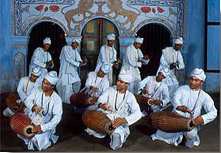Sattriya

The Sattriya dance form was introduced in the 15thcentury A.D by the great Vaishnava saint and reformer of Assam, Mahapurusha Sankaradeva as a powerful medium for propagation of the Vaishnava faith. The dance form evolved and expanded as a distinctive style of dance later on. This neo-Vaishnava treasure of Assamese dance and drama has been, for centuries, nurtured and preserved with great commitment by the Sattras i.e. Vaishnava maths or monasteries. Because of its religious character and
association with the Sattras, this dance style has been aptly named Sattriya.
Sankaradeva introduced this dance form by incorporating different elements from various treatises, local folk dances with his own rare outlook. There were two dance forms prevalent in Assam before the neo-Vaishnava movement such as Ojapali and Devadasi with many classical elements. Two varieties of Ojapali dances are still prevalent in Assam i.e. Sukananni or Maroi Goa Ojah and Vyah Goa Ojah. Sukananni Oja paali is of Sakti cult and Vyah Goa Oja paali is of Vaishnava cult. Sankaradeva included Vyah Goa Ojah into his daily rituals in Sattra. Till now Vyah
Goa Ojah is a part of rituals of the Sattras of Assam. The dancers in a Oja paali chorus not only sing and dance but also explain the narration by gestures and stylized movements. As far as Devadasi dance is concerned, resemblance of a good number of rhythmic syllables and dance postures along with footwork with Sattriya dance is a clear indication of the influence of the former on the latter. Other visible influences on Sattriya dance are those from Assamese folk dances namely Bihu, Bodos etc. Many hand gestures and rhythmic syllables are strikingly similar in these dance forms.
Sattriya dance tradition is governed by strictly laid down principles in respect of hastamudras, footworks, aharyas, music etc. This tradition, has two distinctly separate streams - the Bhaona-related repertoire starting from the Gayan-Bhayanar Nach to the Kharmanar Nach, secondly the dance numbers which are independent, such as Chali, Rajagharia Chali, Jhumura, Nadu Bhangi etc. Among them the Chali is characterized by gracefulness and elegance, while the Jhumura is marked by vigor and majestic beauty.
